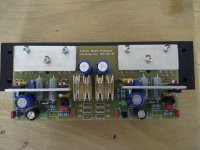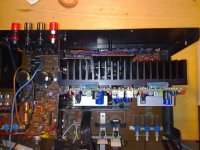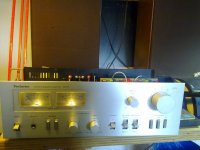Technics SU-Z1 to refurbish - please help!
I have an old Technics SU-Z1 stereo integrated amplifier that is (again) blown. For precedent experience, I know that one channel of the STK amplifier chip inside is short. Also one Re is gone, and the PSU needs repair. Nothing really difficult, but... I do not want to repair it as is, because it is a very silly weak system, prone to get hot and fail.
But, since the aestethics is still very nice (lovely analog VU-meters..), I would like to:
1)Rebuild /recap the PSU
2)Bring out the preamplified signals, to use it as a pre-only.
3)Build in a rugged SS OP, with proper H/S .
For this I would need the SCHEMATICS/SERVICE MANUAL. Anyone can help?
BTW I remember that one eminent member here (I beleieve Wahab) had it in the past and found some design problems. I will be grateful if he can share... In the worst case I'll keep the box and the trafo and throw the rest.
Thanks in advance
effebi
I have an old Technics SU-Z1 stereo integrated amplifier that is (again) blown. For precedent experience, I know that one channel of the STK amplifier chip inside is short. Also one Re is gone, and the PSU needs repair. Nothing really difficult, but... I do not want to repair it as is, because it is a very silly weak system, prone to get hot and fail.
But, since the aestethics is still very nice (lovely analog VU-meters..), I would like to:
1)Rebuild /recap the PSU
2)Bring out the preamplified signals, to use it as a pre-only.
3)Build in a rugged SS OP, with proper H/S .
For this I would need the SCHEMATICS/SERVICE MANUAL. Anyone can help?
BTW I remember that one eminent member here (I beleieve Wahab) had it in the past and found some design problems. I will be grateful if he can share... In the worst case I'll keep the box and the trafo and throw the rest.
Thanks in advance
effebi
Last edited:
Yes, spot on. I'm going to order a couple of PCBs from ESP...i have various SU schematics but not the SUZ 1 may 2 is close .... by the way this is a drama amplifier i think way to many ic to unable to control the obvious ...
i see a pair of neat p3A boards installed inside pretty fast ha ha ha
but I'll want to save the pre-ampli, volume,selectors, etc. and a schematic would cut down the times to 1/10... So if you can send me the SU-Z2 it may help anyway.
Thank you
effebi
They are crap, defenetly they are. I was repairing it around 1984 (got original spare part from a friend working for Panasonic). I also redid the PSU putting serious diodes in place of the toys that where burnt.STK2038 output IC? They were crap, forever blowing up. You'll probably find it's connected to an AN7602 IC for the frontend. If that's the case, look at what's connected to pin 2 and 17 of the AN7602
Then it went to my bro that had blown it right away in a couple of years. Now it is sitting sadly in a rack from more tha 10 years, and I want to do something. Only the case is too nice to be trashed. I found the STK on ebay, but I do not want that s***t again. The only problem is that I would have to find out the connections using only the STK schematic.
Thanks a lot for the infos on the AN 7602, I'll have a look.
Does it act as a VAS stage as well or only a pre-amplifier? It would be too nice to slam there only a CFP pair wired on the H/S!
effebi
Thank you very much, Sakis, it was very kind of you.of course no prob schematic is available email me .
kind regards sakis
BTW, I discovered that the output chip is a STK2028 (probably a reduced power version of the 2038) and that the Input/VAS stage is done by 2X AN7060 chips, that are mono (and SIL )versions of the 7062
The bad news is that the tone controls go through the 7060 as well, so it has to be kept if this function has to be preserved. I believe that was the problem found by Wahab (sorry if i do not remeber well) as well.
Considering that at the end this would be something like a 25+25 W amplifier, I am not so sure it is worth the effort.
effebi
The bad news is that the tone controls go through the 7060 as well, so it has to be kept if this function has to be preserved. I believe that was the problem found by Wahab (sorry if i do not remeber well) as well.
Considering that at the end this would be something like a 25+25 W amplifier, I am not so sure it is worth the effort.
effebi
I cant see how you can be blowing stk modules like this. I've built amps with these a couple of times and literally abused the **** outta them and never had one blow.
I even removed the heatsink once, took 30 minutes of overheating before the thing finally died.
I'd say these modules are pretty darn rugged and reliable. Though i've only dealt with the low power ones below 45 watts.
However i don't see why these would be any less reliable than any discrete design, since they after all are little discretely built amplifiers inside the plastic.
Heres my latest play with these modules: http://www.youtube.com/watch?v=yAMbthSlQOA
I even removed the heatsink once, took 30 minutes of overheating before the thing finally died.
I'd say these modules are pretty darn rugged and reliable. Though i've only dealt with the low power ones below 45 watts.
However i don't see why these would be any less reliable than any discrete design, since they after all are little discretely built amplifiers inside the plastic.
Heres my latest play with these modules: http://www.youtube.com/watch?v=yAMbthSlQOA
Last edited:
Well, I really do not know .I cant see how you can be blowing stk modules like this. I've built amps with these a couple of times and literally abused the **** outta them and never had one blow.
I even removed the heatsink once, took 30 minutes of overheating before the thing finally died.
I'd say these modules are pretty darn rugged and reliable. Though i've only dealt with the low power ones below 45 watts.
However i don't see why these would be any less reliable than any discrete design, since they after all are little discretely built amplifiers inside the plastic.
Heres my latest play with these modules: YouTube - STK407-050 without cover blasting it
The amplifier was original the first time and repaired with original parts the second time.
But I let you guess something, since it look like you are curious.
The rails of this amplifier are + - 39V.
This accounts for a theoretical about 100 W on 8 Ohm, per channel.
(the VU meter says the same , BTW).
Then the amplifier has built-in output for two groups of speakers, than can be selected together. With 2 groups you are sure that you get 4 Ohm or less.... This accounts for something like 200W per channel. One single chip.
And.... there is no H/S !!! the whole thing hangs on a sinple "U" of 2mm bleach with a FLAT surface of no more than 250 cm2. No fan.
There are NO rail fuses, or output protection of any sort (the chip itself might have, I do not know).
Ok, the transformer (well fused and thermal protected on primary), by its size looks like it is no more than 100 VA, the PS capacitors are only 6800 uF, so that power will never come out in the reality.
But if you do a little math, you can see why things can go wrong in a hot italian summer.
As side note: The original STK 2028 it is very hard to find, even the datasheet.
effebi
I cant see how you can be blowing stk modules like this. I've built amps with these a couple of times and literally abused the **** outta them and never had one blow.
I even removed the heatsink once, took 30 minutes of overheating before the thing finally died.
I'd say these modules are pretty darn rugged and reliable. Though i've only dealt with the low power ones below 45 watts.
However i don't see why these would be any less reliable than any discrete design, since they after all are little discretely built amplifiers inside the plastic.
Heres my latest play with these modules: YouTube - STK407-050 without cover blasting it
probably export versions of STK for sverige had extra safety options
ha ha ha ha ...
beyond the joke your remark is wrong .....
STK is ok for average users and casual listening with low expectations if pushed they will fail no more or no less than ordinary transitor circuits ...may be a bit easier ... Problems are that sound has never been perfect or even close and one way or an other normally designs that use STK inside are allready compromized when it comes to supply/heatsink and/or peripherals
Last edited:
"To the curb"
Every single STK module amp/reciever that I ever repaired (100+ of them) , either the full module was blown or one channel was toast (stereo chip). All the units that I have pilfered the trafo's out of have had full module failure (50+). Most modules had their zinc oxide thermopaste totally dry out , most likely leading to failure ... some have been shorted , either by dummies or cheap speakers. All PCB's attached to said modules have cold solder joints and heat stress (burnt) , on some modules this would be the cause of failure.
I broke open quite a few sanyo modules. They appear to be large sanken output devices (2 dies) , thick film resistors , and various other small signal bjt's all glued to the slug.
PS - most STK's are actually "blameless's" with CCS's and a EF2-sanken OP.
OS
Every single STK module amp/reciever that I ever repaired (100+ of them) , either the full module was blown or one channel was toast (stereo chip). All the units that I have pilfered the trafo's out of have had full module failure (50+). Most modules had their zinc oxide thermopaste totally dry out , most likely leading to failure ... some have been shorted , either by dummies or cheap speakers. All PCB's attached to said modules have cold solder joints and heat stress (burnt) , on some modules this would be the cause of failure.
I broke open quite a few sanyo modules. They appear to be large sanken output devices (2 dies) , thick film resistors , and various other small signal bjt's all glued to the slug.
PS - most STK's are actually "blameless's" with CCS's and a EF2-sanken OP.
OS
Last edited:
The 2028 and 2038 were not very reliable and yes, frequently under-heatsinked - however Sanyo marketed them as able to withstand higher operating temperature, thus meaning less heatsink...
It's quite common to fine the Tone controls implemented in the feedback loop of the power amplifier. It's a really bad idea though. Maybe you should keep the controls but completely rebuild both pre and power amp circuits.
It's quite common to fine the Tone controls implemented in the feedback loop of the power amplifier. It's a really bad idea though. Maybe you should keep the controls but completely rebuild both pre and power amp circuits.
Mission Accomplished!
Well, as usual, our good Sakis was correct.
I did exactly that...
Made up a P3A from ESP original PCB,
Recapped PS, new output connectors.
And that's it!
Only the tone controls are inoperative, since they were built between the original front end and the STK module (that is OP only). Too much complicate to preserve them, for what they are worth...
And, how it sounds... well, it never did like that. Even with my 25 years younger hears. The bass are respectable, the highs are crystal clear and the voices,really, ubeliveable. Ella Fitzgerald is now singing in front of me, ...wow!
Well, as usual, our good Sakis was correct.
I did exactly that...
Made up a P3A from ESP original PCB,
Recapped PS, new output connectors.
And that's it!
Only the tone controls are inoperative, since they were built between the original front end and the STK module (that is OP only). Too much complicate to preserve them, for what they are worth...
And, how it sounds... well, it never did like that. Even with my 25 years younger hears. The bass are respectable, the highs are crystal clear and the voices,really, ubeliveable. Ella Fitzgerald is now singing in front of me, ...wow!
Attachments
Thanks, Jaycee. Most of the work was "mechanics" i.e. to cut the frame and tap threads on the heat sink in order to fit the new P3A heart inside.
I might add that, for good measure, I added a slow 12V fan on the bottom of the Heat sink. It fits perfectly the 80mm "U" shaped frame that was previously holding the module, it has intake on the bottom and output on the top. I used the 7.2 Vca for the VU meters light with a diode with a 100 uf capacitor to supply it.
BTW Bias was set just to avoid crossover distortion at 40 mA and offset is under 3 mV on both channels.
I have also taken some scope measurements to show what this P3A is capable of in my implementation (mainly own choice and selection of transistors). When I will find out a reader capable of the old MMC of my scope I might attach them here, if anybody is interested.
I might add that, for good measure, I added a slow 12V fan on the bottom of the Heat sink. It fits perfectly the 80mm "U" shaped frame that was previously holding the module, it has intake on the bottom and output on the top. I used the 7.2 Vca for the VU meters light with a diode with a 100 uf capacitor to supply it.
BTW Bias was set just to avoid crossover distortion at 40 mA and offset is under 3 mV on both channels.
I have also taken some scope measurements to show what this P3A is capable of in my implementation (mainly own choice and selection of transistors). When I will find out a reader capable of the old MMC of my scope I might attach them here, if anybody is interested.
- Status
- This old topic is closed. If you want to reopen this topic, contact a moderator using the "Report Post" button.
- Home
- Amplifiers
- Solid State
- Tecnics SU-Z1 to refurbish


